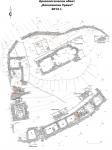Summary (English)
URVICH FORTRESS (Boni Petrunova – boni_boon@abv.bg) The monastery covered an area of 1372 sq. m. St. Elias Church is situated in its northern part and the dining room and the kitchen were discovered in its western wing. The monks’ cells were situated in the southern sector of the monastery. The finds discovered to the north of Room 3 included a Mediaeval gilded appliqué from a diadem, eight coins (including a hoard of six coins from Theodosius II to Leo I the Thracian), a coin of the 4th century AD and a lead appliqué showing a warrior, all of them (except for the Mediaeval gilded appliqué) originating the Late Antique stratum destroyed during the construction of the monastery. Foundations of walls and finds of the 4th – 6th centuries AD were discovered to the north of Room 7a. Debris from roof was discovered in Room 2 situated in the southwestern part of the monastery and a Mediaeval spherical bead and two coins of the 5th century AD were found. Four Christian burials were discovered in the monastery: Grave No. 1 situated to the northwest of Room 1 and Graves Nos. 2 of an adult, 3 and 4 of children discovered in Sondage 5. The finds from the excavations included bronze belt buckle and point of the 6th – beginning of the 7th century AD, bronze coins: 25 AE4 coins – two of Constantine the Great and Licinius I and 23 of Theodosius I, Theodosius II, Honorius, Marcian, Valentinian III and Leo I the Thracian, three folles with the value of 5, 16 and 40 nummi of the 6th – beginning of the 7th centuries AD, two coins of the Second Bulgarian Kingdom: one copper and a silver aspra of King Ivan Alexander minted in the middle of the 14th century, an Indian gold coin with the name of the Abbasid Caliph in Cairo Al-Hakim II (1341–1352), two silver akçe of the Ottoman period.
- Boni Petrunova - National Museum of History
Director
Team
Research Body
- Archaeological Institute with Museum






![Download [PDF]](/excavation/skins/fasti/images/results/download_sml.png)

